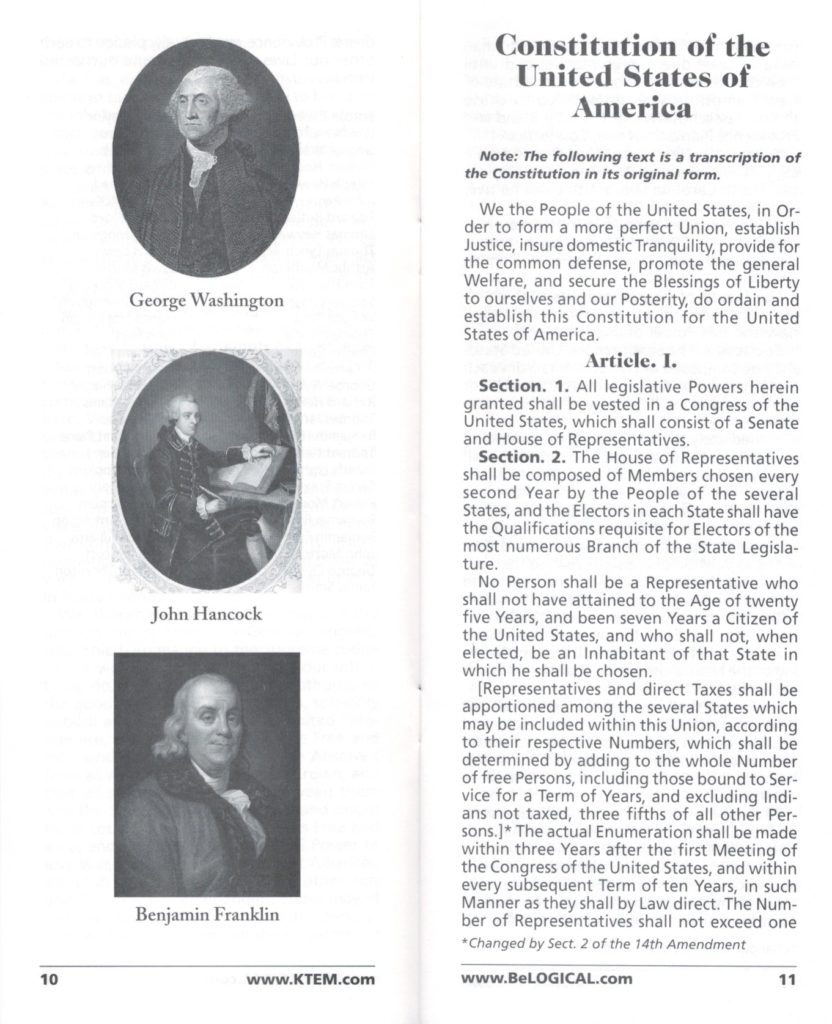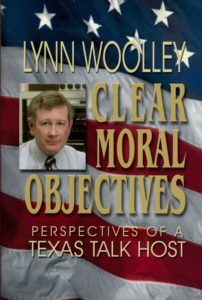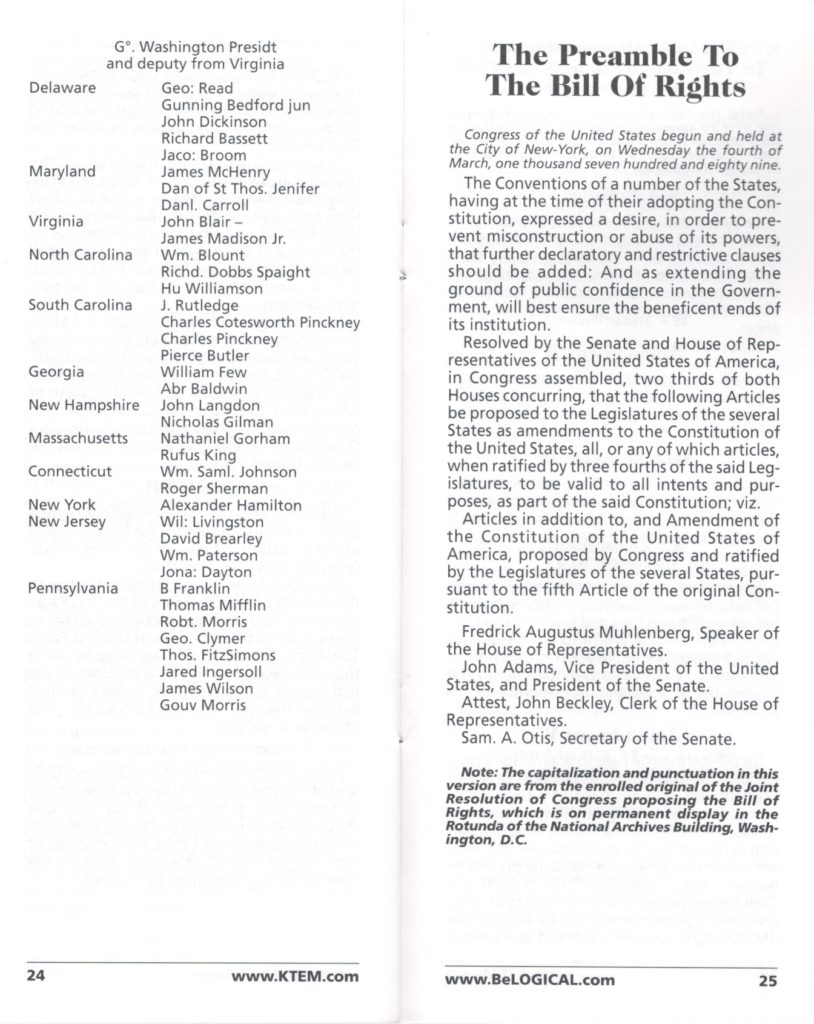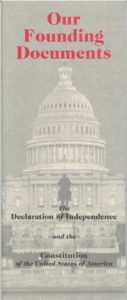Return to the Constitution
Editor’s Note: This article is part of a series written for The Epoch Times and its “American Promise” program. This article was adapted from the book “Clear Moral Objectives” (2003) by Lynn Woolley.
Today’s political divide is nothing new; in fact it has been much worse than it is now, even to the boiling point of a bloody Civil War between North and South. And so it was with the Framers of the Constitution as they convened to create a document that would serve as the basis for our limited government and our precious freedoms.
It’s quite true that they argued and haggled and some of them walked out. But in the end they compromised, and in so doing, they created the greatest document of governance known to humankind – the Constitution of the United States of America.

Page from “Our Founding Documents” designed by Jody Donaldson and distributed by the Lynn Woolley show.
That the Constitution is a great document is generally accepted by Americans these days – even by those who utilize it to create rights or powers that simply aren’t there. But at the time of its creation, the document was not in great favor with all of the people, the states or even the men who framed it. The final document, after all, is a collection of compromises designed to satisfy an assemblage of statesmen with differing views on what the new nation should be. Benjamin Franklin, for example, was not entirely pleased, but he was willing to accept it: “I doubt…whether any other Convention we can obtain, may be able to make a better Constitution…Thus I consent…to this Constitution because I expect no better, and because I am not sure, that it is not the best.”
It was with some urgency that Alexander Hamilton organized the convention. After all, the United States was in danger of falling apart, and several statesmen, including George Washington, were calling for a drastic revision of the government.
So the delegates met in Philadelphia on May 25, 1787, originally to rewrite the Articles of Confederation. It became apparent to a majority that a re-write was not enough and that a new document was needed. It’s interesting to note that John Adams and Thomas Jefferson were out of the country on government business and did not attend, while Patrick Henry and Samuel Adams refused to participate because they opposed the creation of a strong central government. The State of Rhode Island declined to send a delegate because it was afraid that its trade would suffer under national regulations.
Fifty-five delegates were present for the near-continuous debates, and 39 of them signed the Constitution on September 17, 1787, including George Washington, 81-year-old Benjamin Franklin, James Madison, Alexander Hamilton, and Gouverneur Morris, who did much of the writing. Madison is known as the “Father of the Constitution” because of his negotiations and extensive records of the debates.
In some areas, the Constitution was precise in framing the basic laws of the land. But in other areas it was vague, perhaps an indication that the Framers purposefully were setting up the document to endure through the ages. A contributing factor to the vagueness of certain sections is surely the wide range of views that the Framers brought to the table about what form of central government the United States ought to have.
Had the Articles of Confederation endured, today’s United States would be very different since the Articles recognized the sovereignty of the individual states. In the end, the view of a national centralized government won out, but there can be no doubt that the Constitution is designed to place severe limits on that government’s powers. To that end, the Constitution provides for a “federal” system that splits powers between the national government and the states. Furthermore, it establishes a method of “checks and balances” by mandating three branches of government – one to create the laws (the Congress), one to enforce them (the president) and one to interpret them (the judiciary.)
Even so, there was adamant opposition to the new Constitution when it was sent to the various states for ratification on September 28. Some, such as Virginia’s Richard Henry Lee, a signer of the Declaration of Independence, were still against increasing the powers of Congress. “The first maxim of a man who loves liberty,” said Lee, “should be never to grant to rulers an atom of power that is not most clearly and indispensably necessary for the safety and well being of society.” Lee thought that the convention had exceeded its powers because it was only authorized to rewrite the Articles of Confederation, and he was unhappy that the final document had not included a bill of rights. Patrick Henry, still opposed to a national government, also argued hard against ratification.
Others, such as Alexander Hamilton – even though he wasn’t completely happy with the new document – worked to get it ratified. Along with Madison and John Jay, he published The Federalist, a collection of eighty-five essays in support of the need for a central government. In the essays, Hamilton intended to prove that a national government was absolutely necessary to prosperity of the Union and that the present Confederation was insufficient to preserve it. “For nothing can be more evident, to those who are able to take an enlarged view of the subject,” he wrote, “than the alternative of an adoption of the new Constitution or a dismemberment of the Union.”
Eventually, Delaware ratified the Constitution on December 7, 1787 and New Hampshire put it into effect with its ratification on June 21, 1788. Still, there were problems with the Anti-Federalists and with some of the other states such as North Carolina – because of the lack of a bill of rights.
The first Congress convened on March 4, 1789, facing more than a hundred proposed amendments that had come from the states and minority groups, and specific bills of rights from Virginia and New York. Madison suggested 15 amendments, Congress accepted 12 of them, and ten were eventually ratified – the Bill of Rights.
At last the Constitution contained what the Anti-Federalists had most wanted: sweeping declarations preventing the national government from taking away the most fundamental rights of the people. The Tenth Amendment also gave us something else – a clause that reserved for the people or the states those powers that were not specifically delegated to the central government. Likewise, the Ninth Amendment was also purposefully vague, stating that just because certain rights are listed in the Constitution, that doesn’t mean that rights not listed are automatically denied.
These amendments have resulted in decades of court cases and judicial interpretations. So have the competing segments of the “Establishment Clause” in the First Amendment, and a modifying clause at the beginning of the Second Amendment. Even articles of the original document still come under dispute, especially when the three branches of government quarrel over separation of powers.
So is the Constitution a “living document” as so many people say it is – or is it a fixed law of the land? The answer lies somewhere in between. The Constitution is a living document when it wants to be, but some parts are set in concrete. Deciding which is which has become a defining issue of our times.
Sometimes, the Supreme Court makes decisions based on the fixed part of the Constitution – those clauses that seem very specific and leave little room for interpretation. For example, Article II, Section One requires that the President of the United States must be a natural-born citizen who has attained the age of 35. If Congress were to pass a law making changes in that requirement, it would be instantly deemed unconstitutional. But this has never stopped Congress from making laws that conflict with the Constitution.
In 1803, the Supreme Court heard the case of Marbury v. Madison in which William Marbury was trying to force a judicial appointment through that he had received from President John Adams. But Adams had left office before the appointment took effect, and Secretary of State James Madison withheld it. Marbury attempted to use Section 13 of the Judiciary Act of 1789 to force Madison’s hand. Instead, the Supreme Court deemed it unconstitutional, saying that Section 13 granted powers to the Court not authorized by the Constitutional. This case set the precedent that laws passed by Congress must be constitutional and that the courts have the power to review them.
The opinion in Marbury, written by the “Great Chief Justice” John Marshall, paved the way for the Judicial Branch to become as powerful as the other two branches of government.
From Marbury, you might conclude that the Supreme Court always considers the obvious intent of the Constitution when deciding whether a law should be overturned. Your conclusion would be wrong. The Supreme Court sometimes makes rulings based on the political conditions and attitudes of the times.
The Fourteenth Amendment states quite plainly that no state shall make a law that abridges the rights, privileges or immunities of citizens of the United States. However, in 1896 at the time of the Plessy v. Ferguson decision, the Supreme Court made a ruling based on current attitudes. John H. Plessy had challenged a Louisiana law that required “separate but equal” facilities for whites and blacks in railroad cars. It took fifty-eight years for the Court to revisit the issue and turn it around in Brown v. Board of Education of Topeka.
And yet, in today’s politically correct atmosphere, that same “Equal Protection Clause” doesn’t stop affirmative action and other race-based programs. There are simply too many people who view what is now called “Diversity, Equity, and Inclusion” as a moral imperative that should trump the crystal-clear intent of the Fourteenth Amendment.
It’s as if the old fight between the Federalists and the Anti-Federalists is still going strong; only the names have changed. Now it’s liberals and progressives against conservatives and those with a libertarian view. They align themselves, either as political parties or as interest groups, and they file lawsuits seeking to find something in the Constitution that will make their ideology the law of the land.
Perhaps the most famous example of Constitution-bending is Roe v. Wade in which a so-called “right to privacy” – emerging from the Ninth Amendment (the enumeration of rights shall not be construed to deny others) — imbues women with a constitutional right to do away with their unborn children. In all probability, the Framers would have looked upon such an interpretation with intense skepticism.
What would they think about some of the other contemporary issues surrounding the Constitution? Even the Federalists of the day might be taken aback at how big and bloated the central government has become and at how much control it exerts over daily life. A case in point is the giant bureaucracy known as the Department of Education. There simply is no constitutional basis for such a department since the principle of federalism leaves authority over education to the states and the people.
The fact is that the Constitution doesn’t authorize a “cabinet” at all, but merely says that the president “may require the opinion, in writing, of the principal officer in each of the executive departments, upon any subject relating to the duties of their respective offices…” At first, there were just three departments – State, War and Treasury – plus the office of the Attorney General, all established in 1789.
As time passed, more departments were added including Agriculture; Commerce; Defense (replacing War); Health and Human Services; Housing and Urban Development; the Interior; Labor; Transportation; Energy, Education, and Homeland Society.
These departments and hundreds of other agencies form a giant bureaucracy known colloquially as “The Swamp.” Congress, never a body to allow a crisis to go to waste, often responds to adversity by creating a new department. An energy crisis led to the creation of the Department of Energy. A perceived crisis is education led to the Department of Education, and the terrorist attacks of 9/11 led to the Department of Homeland Security.
All these departments are deemed constitutional by the mere fact that the Constitution mentions “executive departments.” But does that trump the language of the Tenth Amendment which leaves to the states those powers not designated to the central government? The only departments that seem absolutely necessary to the United States government are the departments of Defense, State, and Treasury – pretty much what we had in 1789.
The attacks of 9/11 also gave us the USA Patriot Act, under which the American people may be spied on by our own government without much in the way of judicial review. At the time the Patriot Act was created, civil libertarians expressed concern that that the FBI was given the power to track every thing we do on a computer, and can go to bookstores and libraries to get lists of what we’ve been reading – all in the name of fighting terrorism.
Fast-forward 20 years, and we’ve seen a powerful intelligence community working hand-in-hand with a failed presidential campaign to utilize political opposition research, known as the Steele Dossier, as the pretext for obtaining FISA warrants to spy on certain U.S. citizens that were working for a president they wished to remove from office.
Would the Framers have approved of this? Not likely and certainly not in light of James Madison’s famous warning: “The accumulation of all powers, legislative, executive, and judiciary, in the same hands, whether of one, a few, or many, and whether hereditary, self-appointed, or elective, may justly be pronounced the very definition of tyranny.”
Tyranny is one of the foreseen disasters that the Framers were hoping to avoid through constitutional protections. Another was unnecessary war.
The United States has not declared war since World War II, and yet, we’ve been involved in major wars including the Korean War, the Vietnam War, two Gulf Wars, and Afghanistan plus dozens of lesser incursions into various parts of the globe. Modern presidents often insist that they can go to war without a formal congressional declaration of war as called for in the Constitution. Sometimes, they use prior congressional resolutions as their authority to make war, and sometimes, they simply don’t refer to a military operation as a war.
What about the Constitution? It says only that “The Congress shall have the power…to declare war…” and that the President is “Commander in Chief of the Army and Navy of the United States.” However, the implication that the Congress should be involved in any decision to go to war against another nation is unmistakable.
Just to make sure, Congress passed the War Powers Act specifically stating that its purpose is “to fulfill the intent of the Framers of the Constitution of the United States, and insure that the collective judgment of both the Congress and the president will apply to the introduction of United States Armed Forces into hostilities.” The Act calls on the President “in every possible instance” to consult with Congress before using the armed forces, and to “consult regularly with Congress” until our troops are no longer engaged.
In the specific case of Iraq, there was no emergency that involved repelling a sneak attack and there was no intent on the part of the George W. Bush administration to maintain any strategic secrecy that might be ruined by an open declaration of war. There was certainly a valid case to invade Afghanistan after 9/11, but in neither of these cases did Congress obey the Constitution and declare war.
Of course the Congress could say “no” to war by refusing to fund it, but that would make it seem unsupportive of the men and women in uniform. And so presidents since World War II send our nation’s military around the globe when they want to, with the Congress usually demanding to be heard, but never with any intention of declaring war.
If you see this as a corruption of the Constitution, wait until you consider how your right to vote has been altered. You may ask: does my vote even matter anymore?
You probably think your vote – and those of your fellow citizens — decides the outcome of the congressional race that takes place in your district every two years as called for by the Constitution. To some extent, you’re right; but to very large degree, the right of voters to select representatives to the lower house of Congress has eroded over the years.
Witness this sequence from a newspaper article about a California congressional candidate back in 2002: “Experts say she’s a shoo-in for election to Congress in November from a new California district specifically carved out for a Hispanic.” The candidate, as the article states, was indeed “a shoo-in” and yet no election had been held at the time the article was written; not one single person had voted. How can this be?
To understand how any candidate could have won an election before it had even taken place requires a brief look back at how the Constitution intended for House members to be elected, and what has happened between then and now.
The Framers thought that the election of our representatives to Congress was extremely important – so important that they outlined the procedure in the very first article: “The House of Representatives shall be composed of Members chosen every second year by the People of the several States.” Article I goes on from there to explain more about how House and Senate members should be chosen, but most of that is technical data about age and other qualifications. The key words above are “chosen…by the People…” And that’s how it was in the beginning.
Unfortunately “the People” didn’t include everyone in those early days, and it wasn’t until 1869 when the Fifteenth Amendment was ratified that the right to vote could no longer be denied on account of “race, color, or previous condition of servitude.” That was all well and good, but in some areas, particularly in the South, election officials still refused to allow blacks to vote. In 1965, Dr. Martin Luther King, Jr. led 30,000 people on a march from Selma, Alabama to Montgomery where he demanded that black people be allowed to vote without unfair restrictions. The unrest in Alabama led to the Voting Rights Act of 1965.
The new law strengthened and backed-up the Fifteenth Amendment; recognized that “gerrymandered” districts could dilute minority voting strength; banned the use of a poll tax as a voting requirement; and generally made it possible for thousands of blacks in the South to be able to vote. The Act also prohibited any major changes in voting rules and regulations without approval of the federal courts or the Justice Department and it even specified that the right to vote could not be denied based “on ability to read, write, understand, or interpret any matter in the English language.”
And so, with the Voting Rights Act in place, the United States of America finally had a system in which all of “the People” could now go to the polls and elect their representatives fairly and squarely – right? Well, not exactly. Remember that California candidate had already won her Congressional seat before a vote had been cast. The manner in which she managed to accomplish that feat is the story of how a law can go bad, and how the courts can allow such a law to trump the Constitution.
There can be no doubt that the Voting Rights Act was not only well-meaning, but that it accomplished much for black people who had been unfairly denied the right to vote. In modern times, however, the Act and subsequent court rulings are being used to socially engineer a Congress that “looks like America.” While that may be an admirable goal, it cannot be found in the Constitution.
What the Constitution does say is that “Representatives shall be apportioned among the several States according to their respective numbers, counting the whole number of persons in each State, excluding Indians not taxed.”
Pay close attention to that part about “their respective numbers.” That means that a state like New York could lose a seat if population figures go down while a state like Texas might gain a few seats if the population is booming. Some districts will combine and expand; others will shrink to make way for new districts. That means that when new population figures become available following each census, something called “redistricting” takes place.
And that’s where the opportunity for mischief lies.
The Constitution leaves the times, places, and manner of holding elections for senators and representatives to the state legislatures, and so (with the Senate locked into two senators per state), the legislatures meet to redraw the district lines for house seats. The state politicians who are setting the new boundaries tend to favor their own interests. They engage in massive fights over how many “safe” seats each party should have, and so the whole mess usually ends up before some judge or panel of judges, not mentioned in the Constitution. The court then decides how many districts should go to Republicans and how many should go to Democrats, and (sometimes) what the ethnicity of the elected person should be.
So even though the Constitution says that “the People of the several States” will elect the representatives, the people only get to choose from within a district that is approved by partisan politicians, judges and panels of judges. Sometimes, the legislatures or the courts carve out a district especially for a Hispanic; sometimes, they create one for a black.
The question then becomes: where in the Constitution, or the Voting Rights Act for that matter, does it say that anyone should be creating seats especially for blacks, whites, Hispanics, Democrats, Republicans or anyone else? Of course, it’s not in there. The Constitution laid down the rules, and the Voting Rights Act was supposed to prevent gerrymandering and make sure that the rules were enforced fairly.
Even though redistricting is not one of the bright spots of American democracy, voters do have some say in who gets elected. They decide which Republican, or which Democrat, but the winning party is often preordained. If a court sets aside a predominately minority district, then the ethnicity of the eventual House member is virtually decided before the voting takes place – and of course, most minority districts are safe Democratic seats.
But didn’t the Framers really intend for districts to be compact and kind of square or round in shape? The answer to that is probably “yes” but the Constitution is not specific. So if the court wants a safe seat for a Democrat, the court simply draws a meandering line to take in as many predominately Democratic areas as needed. The political make-up of a state’s Congressional delegation will eventually become what the court — petitioned by a gaggle of politicians and activist groups — thinks it should be.
The entire process is as unconstitutional as can be. Remember that the next time you vote.
Then consider the case the libeled hamburger meat, and you’ll see how a simple application of the First Amendment might have saved a lot of time and court costs.
In 1996, cattlemen filed a lawsuit against talk show queen Oprah Winfrey, her production company and a vegetarian activist who had appeared on her TV program charging that they had violated the Texas “veggie libel” law. You read this correctly; under the “False Disparagement of Perishable Food Products Act,” producers can sue anyone who knowingly makes defamatory statements about vegetables. In effect, the law extends certain protections – once reserved for human beings – to tomatoes and hamburger meat.
Ms. Winfrey ran afoul of the law when her guest – Howard Lyman – stated his opinion that U.S. beef could be at risk of spreading “mad cow disease” and Ms. Winfrey then vowed never to eat another hamburger. After six plodding years, U.S. District Judge Mary Lou Robinson finally tossed the whole case out of court.
But why, if common sense had been applied, would such a ridiculous case have ever made it past opening arguments? Even if a court could accept the notion that it’s possible under the Constitution to libel a hamburger, what about the freedom of speech that the First Amendment guarantees to Mr. Lyman, Ms. Winfrey, and to all other Americans? Ms. Winfrey was obviously not out to destroy the livestock business; she was producing what seemed to her to be an interesting television show. And yet the court case drug on and cost Ms. Winfrey over $1 million in legal fees.
The Framers did not mention anything about hamburgers in the Constitution, but they did recognize that many issues would arise over the ages that they had never considered. And so the Constitution – a patchwork of compromises – was left intentionally vague in some areas. Therefore, the Framers expected future generations to be logical. They vested Congress with the power to make all laws that might be “necessary and proper” and expected that Congress would pass only those laws that were in accordance with the basic laws established in the Constitution.
In other words, the Constitution is the foundation; the laws are the minutia.
Since the laws are much more detailed, we expect the court system – under a concept known as “judicial review” — to make sure that those laws are constitutional. Authorization for judicial review is assumed from the section of the Constitution that sets up the judiciary, creates the Supreme Court and then states, “The judicial power shall extend to all Cases, in law and Equity, arising under this Constitution.” Since Marbury v. Madison, the federal courts have had the power with the final decision resting with the Supreme Court.
But when the courts are reviewing laws, do they always turn to the Constitution, applying it strictly where it is precise and using common sense where it is vague? Sometimes they do, but certainly, not all of the time. Activist judges often get away with imposing their personal view into the law because so many people look at each decision in terms of agreeing or not agreeing with the outcome.
The common sense approach to the Constitution calls for a bias-neutral approach to judicial review. Judges should take their responsibility very seriously to be “strict constructionists” — to apply the Constitution to laws without regard to any personal point of view. Remember, one of the great functions of the Constitution is to set limits on the power of the central government, even though in McCulloch v. Maryland in 1918 the Supreme Court ruled that Congress possessed “implied powers” not specified in the Constitution.
Then how are we to know exactly what the Constitution is trying to tell us in establishing the basic laws of the land? One way is to look at the introduction to the document – its own preamble – which describes in broad terms just five things that the government must do in order to establish a more perfect union:
- Establish justice
- Insure domestic tranquility
- Provide for the common defense
- Promote the general welfare
- Secure the blessings of liberty
So the things that the Framers deemed important were having a fair justice system; keeping the peace; making the country safe from our enemies; improving the welfare of the nation as a whole; and maintaining freedom. How far these basic goals can be stretched, while adhering to the rest of the Document and the principles of common sense and logic, makes all the difference.
Clearly the Framers desired to produce a Constitution that would stand the test of time. The fact that it has been amended only twenty-seven times, and is still small enough to be published in a pocket edition (unlike the voluminous Income Tax Code) is a testament to their success. And yet, for all its relevance and brilliance more than 215 years after its ratification, politicians and judges still play deadly-serious games while attempting to get around it.
As we interpret it, stretch it, redefine it, and use it for various purposes, we have to keep in mind that – at least to a certain extent – that is exactly what the Framers set us up to do. They knew we’d argue about it; after all, they argued about it.
But we owe it to them to argue about the words they wrote in honesty and in truth. “Let us raise a standard to which the wise and honest can repair,” said Washington. But all too often, we aren’t wise at all. Sometimes we ignore the Constitution altogether. And even when we don’t, we spin, we obfuscate, we rummage through – and we quote those little pieces, parts and court decisions that best live up to our own political desires.
While the Framers worked to build a more perfect union, today’s politicians often work to satisfy the demands of various interest groups and voting blocs. That’s what Alexander Hamilton must have meant when he wrote, “The great source of all the evils which afflict republics is that the people are too apt to make choice of rulers who are either politicians without being patriots, or patriots without being politicians.” Hamilton was right. We need great leaders – patriotic enough to put the interests of the United States first, but with the political skills to accomplish worthy goals.
In today’s world, some 235 years after the Constitution was signed, we must be prepared to debate the vital issues of the day with truth and logic aforethought and with an underpinning of solid constitutional principles. Judicial activism and spin are potent weapons in the fight for the soul of the United States of America. But nothing is as powerful as the truth. And no document is more relevant in today’s world than the Constitution of the United States of America.
Lynn Woolley is a Texas-based author, broadcaster, and songwriter. Follow his podcast at https://www.PlanetLogic.us. Check out his author’s page at https://www.Amazon.com/author/lynnwoolley. Order books direct from Lynn at https://PlanetLogicPress.Square.Site. Email Lynn at lwoolley9189@gmail.com.





